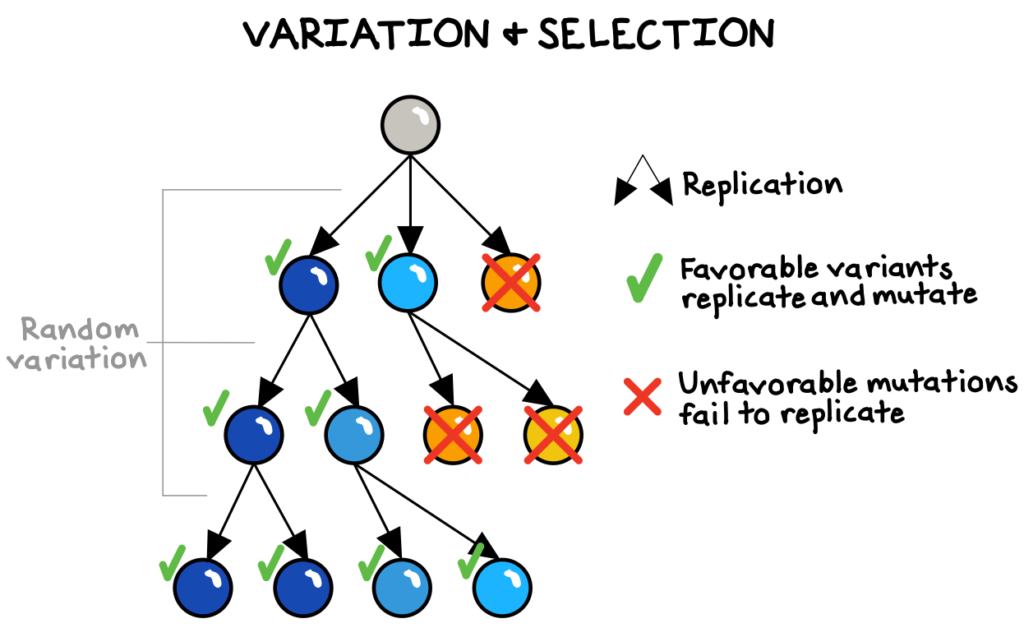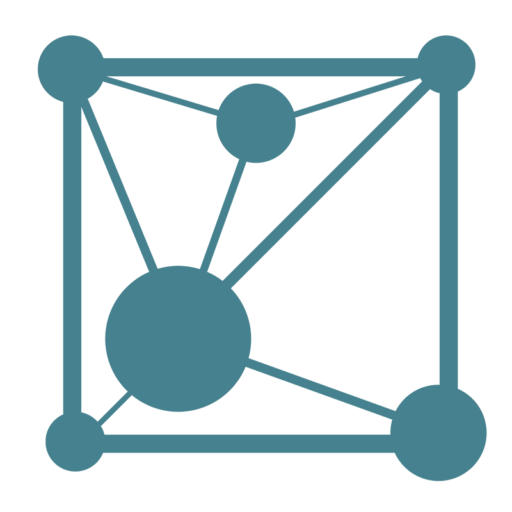Until around the 19th century, it was generally assumed that some supernatural force (such as the Greek gods) was required to explain the complexity and diversity of life. However, Charles Darwin’s theory of evolution in 1859 introduced the revolutionary idea that life’s breathtaking variety doesn’t require any supernatural intervention. The theory’s modern understanding, termed Neo-Darwinism, involves three main processes:
- Replication — All organic life emerges through the copying of genes from parent to offspring;
- Variation — However, the genetic copying process is imperfect, introducing random variation into each generation;
- Selection — Nature acts as a relentless genetic “filter,” favoring gene variants that confer advantages in survival and replication.
Evolution is one of the most powerful theories available to us today, with broad implications across domains and throughout our lives. Let’s dive deeper.
The copying competition
Genes are effectively molecular software programs, bits of chromosomal material encoded simply to manufacture certain chemicals. These low-level molecular programs accumulate into complex systems of control and feedback, ultimately giving rise to the marvelous life forms that we see. Most importantly, genes are “replicators,” entities capable of copying themselves. They are programmed to cause their own replication—for example, through sexual reproduction in animals.1
During the imperfect replication process, random variants emerge. These “mutations” are non-purposeful: they occur without consideration of what problem they might solve. But this random genetic “shuffling” is far from useless: it gives potentially favorable genetic variants a chance to emerge. Certain mutations, by blind luck, will be more successful replicators than others. For instance, a male peacock with bigger, more colorful tail-feathers may have more mating success than his modestly-feathered chum.
“Natural selection” occurs over generations as the gene variants that are best able to cause their own replication survive and dominate, while less effective mutations fade away.2

We observe evolution in all processes subject to some mechanisms of replication, variation, and selection—including in business, where evolution can help us understand the differential success of companies.
Companies that don’t die
In the business world, as in nature, the mechanisms of replication, variation, and selection play a crucial role.
Businesses replicate the strategies, processes, and business models of others. But like mutating genes, startups begin with some different properties from their predecessors, and incumbents adapt and reconfigure themselves over time. These variations might include new product features, pricing models, marketing strategies, or operational processes. Just as natural selection eliminates disadvantageous genes, the market filters out weaker businesses over time. When the environment changes, the organizations that survive are those best able to adapt their resources and strategies to the external selection environment.3
A great example is The New York Times, which has persisted for 170 years as America’s most Pulitzer-decorated news organization and as a thriving business. Digital upheaval from the Internet and smartphones decimated the legacy print newspaper readership and advertising revenue of most newsrooms. The Times, however, recognized the shifting landscape early on—and chose to adapt. The company (controversially) launched a paywalled digital subscription in 2011, aggressively hired and handsomely paid top journalists (even amidst mass layoffs by competitors), and invested heavily in digital and mobile experiences.4 Today, the company’s market-leading 10 million digital subscribers are over 4x its print-era peak.
Netflix offers another striking example. Starting as a DVD-by-mail disruptor in the Blockbuster-dominated DVD rental market, Netflix became a household name—but it did not stagnate. Recognizing shifts in how viewers consumed video content, the company successfully transformed into a pioneer of the digital video streaming market, then led a global revolution in the production of original streaming content.5 Netflix’s ability to foresee and adapt to consumer preferences and technological advancements secured its streaming dominance, while the market filtered out less adaptable competitors such as Blockbuster and Quibi.
Examples like these demonstrate how evolutionary dynamics can help us eliminate common misconceptions about business—such as the idea that success is linear and predictable, or that the best product or the genius CEO or the biggest company always wins. Adaptability and randomness loom large in dynamic environments.
Biological evolution, too, is frequently misunderstood. Exploring these misconceptions can be extremely enlightening.
The “appearance of design” misconception
For one, the remarkable adaptations degree that we observe in nature (such as the body’s ability to heal itself) give an “appearance of design” that leads many people to presume the existence of a supernatural designer (or designers), and to the common misconception that evolution has “goals”—that it optimizes for the species or the individual.
By definition, the designer of an adaptation must have had an intention for that design. But, again, random variation takes place without knowing what problem those mutations might solve. The variants most successful at replication will dominate. There is no goal—no design.
Evolutionary processes are capable of explaining how all life forms evolved from single-cell organisms into highly complex beings, with remarkable yet “unplanned” adaptations—such as a peacock’s extravagant tail or a giraffe’s long neck.6
If life had been “designed,” then wouldn’t all biological traits be perfectly optimized for the good of the organism? This, too, is false.
Evolution can result in useless features, such as the human appendix or the “tail bone” (evolutionary leftovers). Evolution can even favor completely disadvantageous features. For instance, the peacock’s large, colorful tail that attracts mates also makes it more vulnerable to predators.7 The dominant genes may in fact cause a species to go extinct when the environment changes, if they were only well-adapted to conditions that no longer exist.8
The reality is that natural selection is blind. It does not optimize for the “welfare” of anything other than the gene’s ability to replicate itself.
“Organisms are the slaves, or tools, that genes use to achieve their ‘purpose’ of spreading themselves through the population.”
David Deutsch, The Beginning of Infinity (2011, pg. 92)
The “fine-tuning” misconception
A related misconception is the idea that the world appears to be “fine-tuned” to promote life on Earth.
The “parable of the sentient puddle” provides a thought-provoking counterargument: one day, a puddle wakes up and finds itself in a hole that fits the puddle “staggeringly well.” The puddle therefore concludes that the world must have been created for it.
But just as the hole wasn’t created for the puddle, the universe wasn’t sculpted for life. In fact, the opposite is true: We are fine-tuned by evolution to a very limited range of environmental conditions. Mild changes to our environment (temperature, altitude, etc.) would promptly kill us, in the absence of any human knowledge or technology.9
The Earth, in fact, is often indifferent or even hostile to life. Perhaps 99% of all species that have ever existed on Earth are extinct. Much of the Earth’s life-support system was not bestowed upon humans but created by them, using their distinct ability to create knowledge.10
Why humans actually are special
This revelation leads to perhaps the most important application of the theory of evolution outside of biology: the creation of human knowledge.
According to the dominant theory of knowledge-creation, philosopher Karl Popper’s “critical rationalism,” science is a problem-solving process that resembles biological evolution.
Ideas, like genes, are replicators. New theories emerge from creative guesswork by humans, which introduces variation into the knowledge-creation process (similar to genetic mutation). Then, we subject our ideas to a selection process by which we test them logically and experimentally. When a theory fails to survive criticism, we abandon it. If a new theory displaces it, we tentatively deem our problem-solving process to have made progress.11
Unlike biological evolution, in which bad genes are eliminated through the death of their carrier organisms, we are free at any time to discard our old ideas or to invent and test new ideas. This is one reason why knowledge creation is exponentially faster and more efficient than biological evolution. We can, in Popper’s words, “let our theories die in our stead”!
***
With humans, in some ways evolution produced a system of trial-and-error even more powerful than evolution itself. We evolved not only to survive but to explain and reshape nature, as evidenced by our cities, technologies, agriculture, and science. Our genes are coded only to selfishly perpetuate themselves, but we can transcend this programming and create genuinely altruistic societies. Recognizing our unique evolutionary position, we can build a future that not only ensures our survival but also amplifies our thriving!
Notes
- Deutsch, D. (1997). The Fabric of Reality. Penguin Books. 169-176.
- Deutsch, D. (2011). The Beginning of Infinity. Penguin Books. 89-93.
- Teece, D. (2014). The Foundations of Enterprise Performance. The Academy of Management Perspectives, 28(4), 328-330.
- The (Not Failing) New York Times [Web blog post]. (2020, October 1).
- Helmer, H. (2016). 7 Powers. Deep Strategy LLC. 20-22.
- Marletto, C. (2021). The Science of Can and Can’t. Viking. 8-11.
- Deutsch, D. (2011). 89-93.
- Gribbin, J. (2004). Deep Simplicity. Random House. 206-207.
- Tallinn, J. (2019). Dissident Messages. In J. Brockman (Ed.), Possible Minds. Penguin Press. 97.
- Deutsch, D. (2011). 47-50.
- Deutsch, D. (1997). 65-69.

